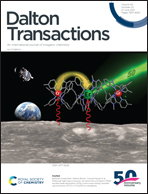Kinetically labile ruthenium(ii) complexes of terpyridines and saccharin: effect of substituents on photoactivity, solvation kinetics, and photocytotoxicity†
Abstract
Herein, we designed six kinetically labile ruthenium(II) complexes containing saccharin (sac) and 4′-substituted-2,2′:6′,2′′-terpyridines (R-tpy), viz. trans-[Ru(sac)2(H2O)3(dmso-S)] (1) and [RuII(R-tpy)(sac)2(X)] [X = solvent molecule] (2–6). We intentionally kept the labile hydrolysable Ru–X bonds that were potentially activated via solvent-exchange reactions. This strategy generates a coordinative vacancy that allows further binding with potential biological targets. To gain insight into the electronic effects of ancillary ligands on Ru–X ligand-exchange kinetics or photoreactions, we have used a series of substituted terpyridines (R-tpy) and studied their solvation kinetics. The ternary complexes were also studied for their potential utility in Ru-assisted photoactivated chemotherapy (PACT) synergized with release of saccharin as a highly selective carbonic anhydrase IX (CA-IX) inhibitor, over-expressed in hypoxic tumors. The ternary complexes exhibit distorted octahedral geometry around Ru(II) from two monodentate transoidal saccharin in the axial position, and tridentate terpyridines and labile solvent molecules at the basal plane (2–6). We studied their speciation, solvation kinetics, and photoreactivity in the presence of green LED light (λirr = 530 nm). All the complexes are relatively labile and undergo solvation in coordinating solvents (e.g. DMSO/DMF). The complexes undergo the ligand-substitution reaction, and their speciation and kinetics were studied by UV-Vis, ESI-MS, 1H-NMR, and structural analysis. We also attempted to assess the effect of various substituents on the ancillary terpyridine ligand (R-tpy) in photo-reactivity and ligand-exchange reactions. The photo-induced absorption and emission measurements suggested dissociation of the saccharin from the Ru-center supporting PACT pathways. The complexes display a significant binding affinity with CT-DNA (Kb ∼ 104–105 M−1) and bovine serum albumin (BSA) (KBSA ∼ 105 M−1). Cytotoxicity was studied in the dark and the presence of low energy UV-A light (365 nm) in cervical cancer cells (HeLa) and breast cancer cells (MCF7). Photoirradiation of the complexes induces the generation of reactive oxygen species (ROS) assessed using 1,3-diphenylisobenzofuran (DPBF) and intracellular DCFDA assays. The complexes are sufficiently internalized in cancer cells throughout the cytoplasm and nucleus and induce apoptosis as studied by staining with dual dyes using confocal microscopy.



 Please wait while we load your content...
Please wait while we load your content...